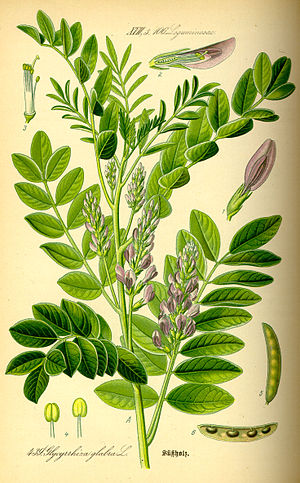γλυκύρριζα
ζηλοῦτε δὲ τὰ χαρίσματα τὰ μείζονα. Καὶ ἔτι καθ᾽ ὑπερβολὴν ὁδὸν ὑμῖν δείκνυμι (1 Corinthians 12:31) → But go ahead and strive for the greater gifts. And I'm about to show you a still more excellent way.
English (LSJ)
ἡ,sweet-root, i.e. liquorice, licorice, Glycyrrhiza glabra, Dsc.3.5, Antyll. ap. Orib.10.24.4:—also γλυκύρριζον, τό, Gp.7.24.4, and γλυκύρριζος, ἡ, Hsch.
Greek (Liddell-Scott)
γλῠκύρριζα: ἡ, φυτόν τι μετὰ γλυκείας ῥίζης, «γλυκόρριζα», Διοσκ. 3. 5· γλυκύρριζον, τό, Γεωπ. 7. 24.
Spanish (DGE)
-ης, ἡ
• Alolema(s): γλυκύρι- Hp.Mul.1.78, Gal.19.739
bot. regaliz de espinas, Glycyrrhiza echinata L. y regaliz, Glycyrrhiza glabra L., Hp.l.c., Dsc.3.5, Antyll. en Orib.10.24.4, Gal.l.c., Scrib.Larg.75, Plin.HN 21.91.
Greek Monolingual
η
βλ. γλυκόριζα.
Wikipedia EN
Liquorice (British English) or licorice (American English) (/ˈlɪkərɪʃ, -ɪs/ LIK-ər-is(h)) is the common name of Glycyrrhiza glabra, a flowering plant of the bean family Fabaceae, from the root of which a sweet, aromatic flavouring can be extracted.
The liquorice plant is a herbaceous perennial legume native to the Western Asia and southern Europe. It is not botanically closely related to anise or fennel, which are sources of similar flavouring compounds. (Another such source, star anise, is even more distant from anise and fennel than liquorice is, despite its similar common name.) Liquorice is used as a flavouring in candies and tobacco, particularly in some European and West Asian countries.
Liquorice extracts have been used in herbalism and traditional medicine. Excessive consumption of liquorice (more than 2 mg/kg/day of pure glycyrrhizinic acid, a liquorice component) may result in adverse effects, such as hypokalemia, increased blood pressure, muscle weakness, and death.
German (Pape)
ἡ, und γλυκύρριζον, τό, Süßwurzel, Süßholz, woraus Liquiritiensaft gemacht wird, Geop. und andere Spätere
Translations
af: soethout; als: lakritze; ar: عرقسوس; arz: عرقسوس; as: যষ্টিমধু; azb: شیرین بیان; az: şirinbiyan; bar: bärndreck; ba: татлы тамыр; bg: женско биле; bn: যষ্টিমধু; bo: ཤིང་མངར།; bs: sladić; ca: regalèssia; cs: lékořice lysá; cy: gwylys; da: glat lakrids; de: echtes Süßholz; diq: sus; dv: ވޭމުއި; el: γλυκόριζα; en: liquorice; eo: vera glicirizo; et: lagritsa-magusjuur; eu: erregaliz; fa: شیرینبیان; fi: lakritsikasvi; frr: swetholt; fr: réglisse; ga: liocras; gl: regalicia; he: שוש קירח; hi: यष्टिमधु; hr: slatki korijen; hsb: słódnik; hu: igazi édesgyökér; hy: քաղցրարմատ; id: akar manis; io: regoliso; it: glycyrrhiza glabra; ja: スペインカンゾウ; jv: oyod legi; kab: asɣaṛ aẓidan; ka: ძირტკბილა; kk: қызылмия; kn: ಅತಿಮಧುರ; ko: 민감초; ku: sûs; lb: séissholz; lt: paprastasis saldymedis; lv: lakrica; mai: मुलेठी; ml: ഇരട്ടിമധുരം; mr: ज्येष्ठमध; ms: akar manis; ne: जेठी मधु; nl: zoethout; no: lakrisplante; oc: regalícia; pa: ਮਲੱਠੀ; pl: lukrecja gładka; pt: regaliz; ro: lemn dulce; ru: лакрица; sa: यष्टी; sco: alicreesh; sh: sladić; simple: liquorice; sl: golostebelni sladki koren; sr: сладић; sv: lakritsrot; ta: அதிமதுரம்; te: అతిమధురం; th: ชะเอมเทศ; tl: likorisa; tr: meyan; uk: солодкий корінь голий; uz: qizilmiya; vec: sugorisia; vls: kalissie; wuu: 光果甘草; zh_yue: 洋甘草; zh: 光果甘草

